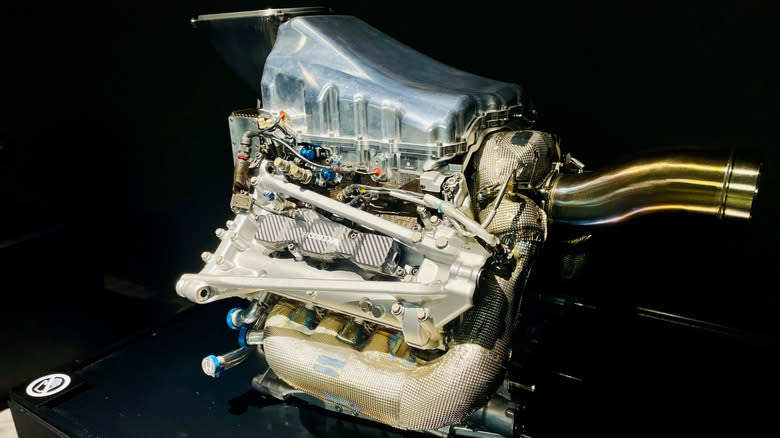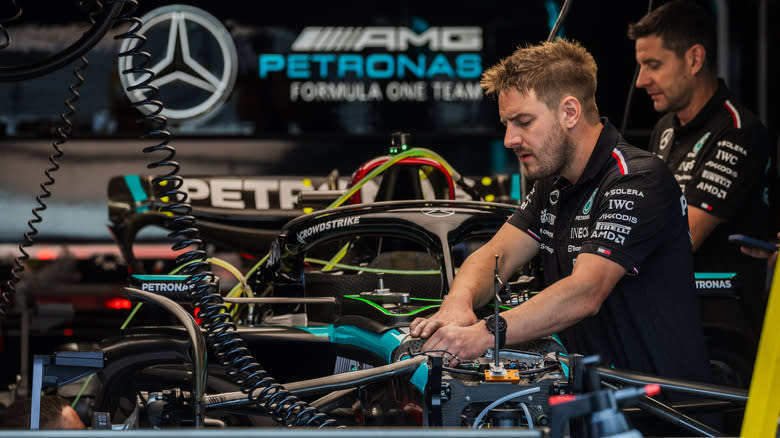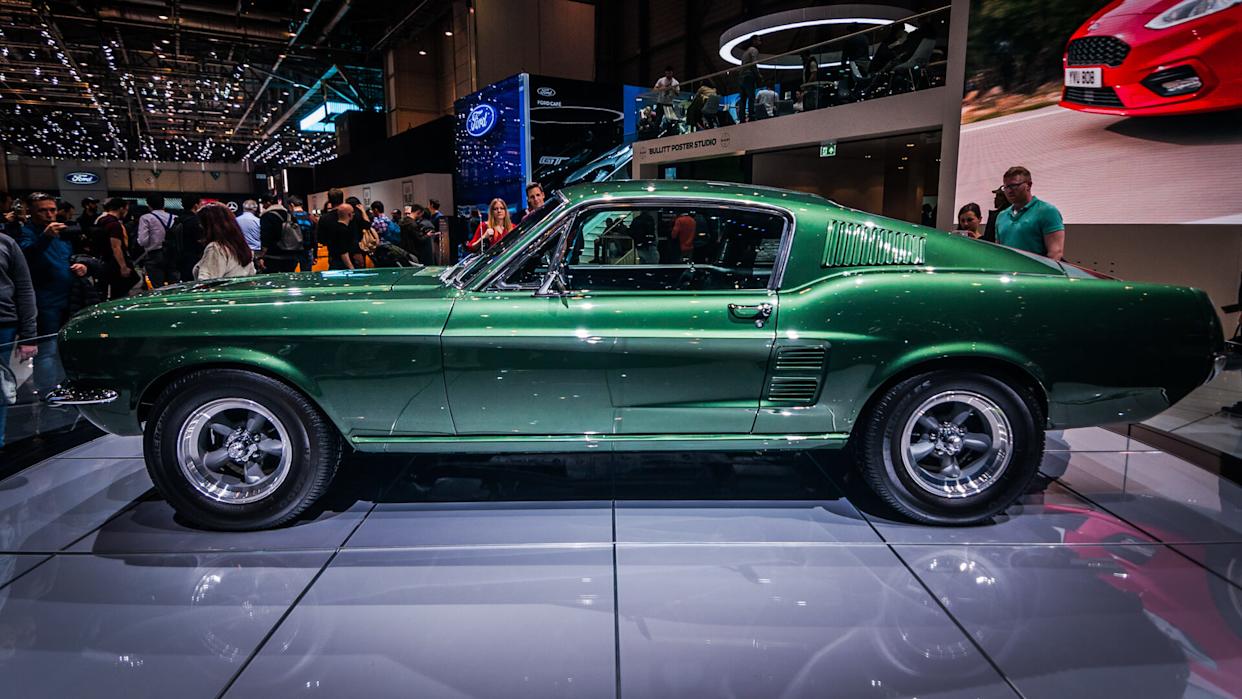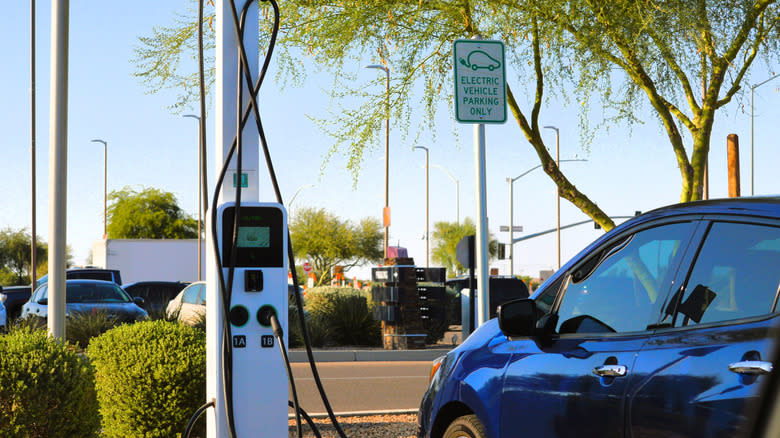
You're here because you find automotive technical minutiae fascinating. While there's plenty of cool engines in passenger cars -- oddities like the Honda S800's roller bearing crank that needs no oil pressure or the Volkswagen Beetle's magnesium engine block and transmission come to mind -- Formula 1 is where engine tech nerds drool themselves to dehydration.
Despite the incredible engineering that goes into F1 engines, they are short-lived. After all, these F1 powertrains generate thrust like you wouldn't believe. 1,000-hp 1.6-liter turbocharged hybrids push these cars to stupendous speeds. Sparks glitter in the dark from the titanium skid blocks that prevent the cars from bottoming out. All this power means these engines will only last for around seven or eight races before they need to be replaced, which means the engine will last about 1,500 miles. This takes into account eight 190-mile races, but not any qualifying or practice. So, the real distance is certainly a bit more.
The engines aren't cheap, either, with estimates ranging from $11 million to just over $16 million per engine. That's more than most of us even dream of spending on cars in our lifetimes, much less an individual engine. Those millions could easily fill a garage with Ferraris, Bentleys, some rare muscle cars, and maybe a six-pack of tricked-out Honda Accords to boot.
Extrapolate that across the four engine allocation each team gets for the 2024 and 2025 seasons -- Formula 1 used to restrict teams to three engines -- and you're looking at $44 million to $64 million. The teams are probably happy that the current $135 million-per-year spending cap doesn't apply to engines.
Read more: Everrati's Electric Porsche 911 RSR Has Me Driving Into The Future With Open Arms
The Money F1 Teams Actually Spend On Engines

That may not be the whole story, however. According to former racer Scott Mansell, who discussed the subject on his Driver61 YouTube channel, F1 teams spent about $16 million in 2023 purchasing engines, but that's when teams still operated under the three-engine-per-season cap. Beyond that, the numbers we hear about how much an F1 engine costs have more to do with development than purchasing.
Look at Forbes' 2019 write-up on F1 engine development costs. The article claimed that developing an F1 engine cost around $1.4 billion, using the Mercedes V6 as an example. Forbes went on to report that Williams and Racing Point spent an estimated $37 million each per year purchasing engines from Mercedes, meaning that if each team had the same budget, they were both forking over $18.5 million.
Where F1 engine costs skyrocket is in the design and manufacturing. Engineers work tirelessly to extract every last horsepower from the allowed parameters, and the machining of each part must be unfathomably precise with tolerances usually measured in double-digit microns. Manufacturing processes must be strictly controlled to prevent inconsistent results.
For instance, maintaining a stable temperature keeps thermal expansion at bay. Scott Mansell's video How Formula 1 Pistons Are Made shows a clip of Dave Herbert, a production engineer for legendary engine builder Cosworth, saying, "If you just held the piston for about ten seconds, it'll go out of tolerance." To ensure parts can be reused after a race, teams will tear the engine down and X-ray parts to ensure there aren't any defects, among many other tests.
Shocking Durability And Relatively Plain Materials

Until 2004, F1 teams could use as many engines as they wanted. Today, the 2025 Power Unit Component Allocation limitations for a 24-race season include eight exhaust systems, four internal combustion engines, four turbochargers, two energy stores, and two sets of control electronics. Exceed these numbers, and expect grid penalties.
Being able to replace an engine every race meant that those screaming V10s back in 2003 weren't the most durable. Don't hold your breath on V10s coming back, either, as hybrids are here to stay in F1 -- for now, at least. Teams would only get an average of 250 miles out of an engine, and considering that's only 60 miles more than the race itself, that meant the engine was essentially designed to last one race.
What's surprising is how conventional the materials are in F1 engines. There's no Vibranium or Adamantium -- McLaren tried using beryllium in its pistons until the FIA banned it in 2001. F1 engines can use aluminum alloys for the block, crankcase, and pistons. Iron-based alloys -- basically steel -- are used for the crankshaft, connecting rods, and cams. Finally, nickel, cobalt, iron, or titanium alloys compose the valves. This is ostensibly to keep manufacturing costs non-exorbitant and avoid safety concerns with exotic materials, as was the case with the FIA's banning of beryllium.
So, with reasonably conventional aluminum and iron alloys and no meteorite metals, F1 engines handle internal temperatures that can far exceed 2,000 degrees Fahrenheit, not to mention incredible pressure. Those pistons have to change direction constantly, as well, at up to 15,000 times per minute. Honestly, it's impressive that F1 engines don't tear themselves apart faster than they do.
Want more like this? Join the Jalopnik newsletter to get the latest auto news sent straight to your inbox...
Read the original article on Jalopnik.






Comments